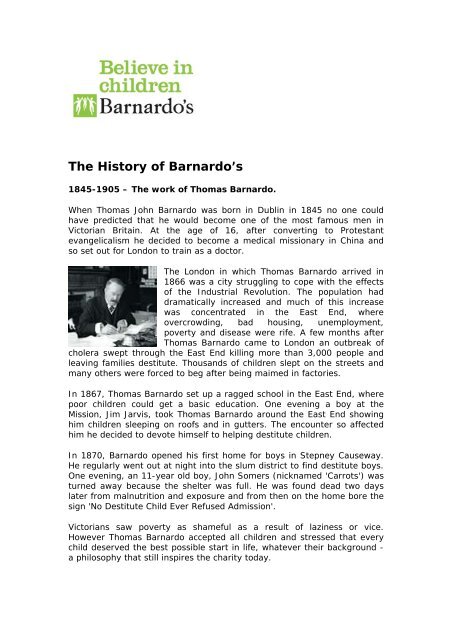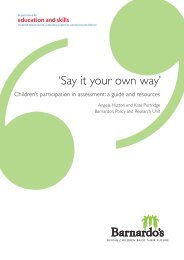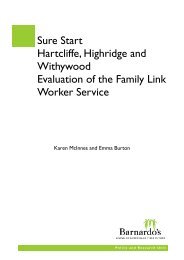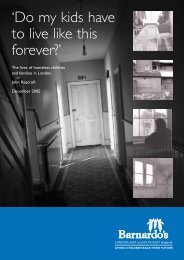The History of Barnardo's
The History of Barnardo's
The History of Barnardo's
Create successful ePaper yourself
Turn your PDF publications into a flip-book with our unique Google optimized e-Paper software.
<strong>The</strong> <strong>History</strong> <strong>of</strong> Barnardo’s<br />
1845-1905 – <strong>The</strong> work <strong>of</strong> Thomas Barnardo.<br />
When Thomas John Barnardo was born in Dublin in 1845 no one could<br />
have predicted that he would become one <strong>of</strong> the most famous men in<br />
Victorian Britain. At the age <strong>of</strong> 16, after converting to Protestant<br />
evangelicalism he decided to become a medical missionary in China and<br />
so set out for London to train as a doctor.<br />
<strong>The</strong> London in which Thomas Barnardo arrived in<br />
1866 was a city struggling to cope with the effects<br />
<strong>of</strong> the Industrial Revolution. <strong>The</strong> population had<br />
dramatically increased and much <strong>of</strong> this increase<br />
was concentrated in the East End, where<br />
overcrowding, bad housing, unemployment,<br />
poverty and disease were rife. A few months after<br />
Thomas Barnardo came to London an outbreak <strong>of</strong><br />
cholera swept through the East End killing more than 3,000 people and<br />
leaving families destitute. Thousands <strong>of</strong> children slept on the streets and<br />
many others were forced to beg after being maimed in factories.<br />
In 1867, Thomas Barnardo set up a ragged school in the East End, where<br />
poor children could get a basic education. One evening a boy at the<br />
Mission, Jim Jarvis, took Thomas Barnardo around the East End showing<br />
him children sleeping on ro<strong>of</strong>s and in gutters. <strong>The</strong> encounter so affected<br />
him he decided to devote himself to helping destitute children.<br />
In 1870, Barnardo opened his first home for boys in Stepney Causeway.<br />
He regularly went out at night into the slum district to find destitute boys.<br />
One evening, an 11-year old boy, John Somers (nicknamed 'Carrots') was<br />
turned away because the shelter was full. He was found dead two days<br />
later from malnutrition and exposure and from then on the home bore the<br />
sign 'No Destitute Child Ever Refused Admission'.<br />
Victorians saw poverty as shameful as a result <strong>of</strong> laziness or vice.<br />
However Thomas Barnardo accepted all children and stressed that every<br />
child deserved the best possible start in life, whatever their background -<br />
a philosophy that still inspires the charity today.
Barnardo later opened the Girls' Village Home in Barkingside, a collection<br />
<strong>of</strong> cottages around a green, which housed 1,500 girls. By the time a child<br />
left <strong>Barnardo's</strong> they were able to make their own way in the world - the<br />
girls were equipped with domestic skills and the boys learnt a craft or<br />
trade.<br />
Thomas Barnardo strongly believed that families were the best place to<br />
bring up children and he established the first fostering scheme when he<br />
boarded out children to respectable families in the country. He also<br />
introduced a scheme to board out babies <strong>of</strong> unmarried mothers. <strong>The</strong><br />
mother went into service nearby and could see her child during her time<br />
<strong>of</strong>f.<br />
1905-1939 – <strong>The</strong> charity after Thomas Barnardo’s death<br />
By the time Thomas Barnardo died in 1905, the<br />
charity he founded ran 96 homes caring for<br />
more than 8,500 children. Residential care<br />
emphasised children's physical and moral<br />
welfare rather than their emotional wellbeing.<br />
Some homes housed hundreds <strong>of</strong> children and<br />
staff were sometimes harsh and distant. Many<br />
adults who grew up in the homes look back with<br />
affection and believe the charity was a true<br />
family. Others remember loneliness, bullying<br />
and even abuse.<br />
Child emigration was extended to Australia after the First World War as it<br />
was still seen as an appropriate response to the social problems <strong>of</strong> the day,<br />
even if by today's standards the practice seems cruel. <strong>The</strong>se ideas<br />
continued largely unchallenged until after the Second World War when the<br />
emphasis shifted towards keeping children and their families together in<br />
the community.<br />
1945- 1960 – <strong>The</strong> charity after the War<br />
<strong>The</strong> war marked a turning point in <strong>Barnardo's</strong> development and the<br />
history <strong>of</strong> childcare in the UK. Evacuation brought 'charity children' and<br />
'ordinary' middle and upper class families into contact with each other and<br />
they gained a greater understanding <strong>of</strong> their circumstances. <strong>The</strong><br />
disruption <strong>of</strong> war also improved understanding <strong>of</strong> the impact <strong>of</strong> family<br />
break ups and effects on children brought up away from home.<br />
<strong>The</strong>n in 1946, a national report (<strong>The</strong> Curtis Report) on children 'deprived<br />
<strong>of</strong> a normal home life' was published, prompting a revolution in childcare.<br />
For the first time, children were acknowledged as the nation's<br />
responsibility. This report paved the way for the Children's Act <strong>of</strong> 1948,<br />
which placed the duty <strong>of</strong> caring for homeless children and those in need<br />
on local authorities.
So, during the 1940's and 1950's <strong>Barnardo's</strong> began working more closely<br />
with families. <strong>The</strong> charity awarded grants to families in difficulties because<br />
the breadwinner was unable to work due to illness or an accident. In the<br />
mid 1950's it developed a scheme to house whole families affected by ill<br />
health, housing problems, unemployment and crime. By the end <strong>of</strong> the<br />
decade almost a quarter <strong>of</strong> the charity's work involved helping children to<br />
stay with their own families.<br />
1960-1999 – Changing times<br />
<strong>The</strong> 1960s were a time <strong>of</strong> radical change for <strong>Barnardo's</strong>. Single<br />
parenthood was becoming more acceptable; greater use <strong>of</strong> contraception<br />
meant that there were fewer unwanted children and improved social<br />
security benefits meant that it was no longer necessary for parents to<br />
hand over their children to <strong>Barnardo's</strong> because they could not afford to<br />
care for them.<br />
<strong>The</strong>se developments and the changes in legislation<br />
meant that the number <strong>of</strong> children received by<br />
<strong>Barnardo's</strong> was decreasing and so a commitment was<br />
made to cut down on residential services and develop<br />
new work with disabled children and those with<br />
emotional and behavioural problems. To reflect this,<br />
the charity changed its name in 1966 from Dr<br />
<strong>Barnardo's</strong> Homes to Dr <strong>Barnardo's</strong>. By the end <strong>of</strong> the<br />
decade plans were made to close down large numbers<br />
<strong>of</strong> homes and to convert them into specialist units.<br />
In the 1990s, society became aware, through a number <strong>of</strong> high pr<strong>of</strong>ile<br />
criminal investigations and public enquiries, that a significant number <strong>of</strong><br />
children in residential care homes in the UK during the last century were<br />
victims <strong>of</strong> physical and sexual abuse, neglect and discrimination. Some <strong>of</strong><br />
those children were among the 350,000 cared for in <strong>Barnardo's</strong> homes<br />
between the 1870s and 1980s. <strong>Barnardo's</strong> deeply regrets the<br />
maltreatment which some children suffered.<br />
Where allegations <strong>of</strong> abuse are brought to our attention, <strong>Barnardo's</strong><br />
immediately informs the police and co-operates fully in any subsequent<br />
investigation. Our Making Connections service specialises in providing<br />
those who were in <strong>Barnardo's</strong> care with access to their records, and<br />
<strong>of</strong>fering support to those trying to come to terms with their past -<br />
particularly those going through a process <strong>of</strong> disclosure <strong>of</strong> abuse.<br />
Today we know how institutional care can rarely be a substitute for a<br />
proper family life, hence our shift <strong>of</strong> focus to working with families and<br />
communities. But, in the circumstances <strong>of</strong> the time, we believe that the<br />
vast majority <strong>of</strong> those in <strong>Barnardo's</strong> care had a more positive experience<br />
and received a better preparation for life than they would have done<br />
without the part that <strong>Barnardo's</strong> played in their lives.
From the 1970s onwards, <strong>Barnardo's</strong> continued to expand its work in<br />
fostering and adoption, and family centres were set up in communities to<br />
support families in deprived areas. <strong>The</strong>y set out to help families facing<br />
problems such as unemployment, poor health, bad housing and poverty,<br />
with the aim <strong>of</strong> defusing the stress and tension that might lead to family<br />
breakdown and child abuse.<br />
In 1988 the organisation changed its name from Dr <strong>Barnardo's</strong> to<br />
<strong>Barnardo's</strong> to reflect the contrast with its Victorian past. <strong>The</strong> last<br />
traditional-style home closed in 1989.<br />
<strong>Barnardo's</strong> pioneered schemes for young juveniles and disabled children<br />
and throughout the 1980s and 1990s developed new areas <strong>of</strong> work in<br />
response to public concern over issues such as child sexual abuse,<br />
homelessness and children affected by HIV/AIDS.<br />
21 st Century – What Barnardo’s does now<br />
Today we continue Thomas Barnardo’s work<br />
and Barnardo’s is a leading children's charity<br />
working directly with over 110,000 children,<br />
young people and their families every year.<br />
Today, we run 394 vital projects across the UK<br />
to help some <strong>of</strong> the most vulnerable children<br />
and young people believe in themselves.<br />
Our projects work with lots <strong>of</strong> issues; from<br />
family drug misuse to disability; from youth<br />
crime to mental health; from sexual abuse to<br />
domestic violence. Barnardo’s believes we can<br />
bring out the best in every child, and that all<br />
children deserve the chance to fulfil their<br />
potential.<br />
We use our expertise and knowledge to campaign for better care for<br />
children, and to champion the rights <strong>of</strong> every child. We also run award<br />
winning advertising campaigns to help us spread the word about<br />
vulnerable children.<br />
Find out more at www.barnardos.org.uk
















